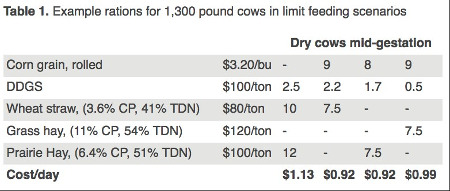Drought-induced forage shortages across some areas of South Dakota has livestock producers looking for different ways meet forage needs left when pastures and hay ground are no longer an option. Corn is one such option, said Julie Walker, Associate Professor & SDSU Extension Beef Specialist.
"Research has shown that a variety of feedstuffs can be utilized to meet the cows' nutrient requirements with similar performance to a forage based diet. "At current feed prices, substituting corn for forage is a viable option to feed beef cows," Walker said. "Corn or corn-based by-products can be used to substitute for forages and save on daily feed costs. For operations with the right facilities and management ability, replacing forage with corn can stretch forage supplies and potentially reduce feed costs."
Meeting Nutritional Needs
Research at The Ohio State University reported pregnant beef cows can be fed as little as 3 pounds of hay plus corn and supplements to meet nutrient requirements.
Purdue University research has also shown that late gestation cows could be successfully fed diets where hay was limited to 0.5 or 1.0 percent of bodyweight (dry matter basis).
"Rations were balanced to meet nutrient requirements, and performance (weight gain) was equal or greater compared to cows receiving hay at 2 percent of body weight," Walker said.
In both of these research projects, corn plus a protein supplement were used to balance the ration.
Table 1 shows a couple of examples of rations that meet the nutritional needs for a 1,300 pound dry cows. Limit feeding corn reduces forage requirements by 50 percent compared to a full-feed hay diet. In the two examples using corn, cows are allocated 0.5 percent of their body weight in forage dry matter (1,300 x 0.005 = 6.5 pounds DM; 6.5/.88 (88 percent DM of forage = 7.4 pounds as-fed).
Based on the prices used, incorporation of high amounts of corn reduced the feed cost/day and stretched the forage supply. It is very important to note that although nutritional requirements of these cows are met, her appetite is not.
Management Considerations
Switching from a forage-based system to a concentrate-based ration creates some management considerations.
* Facilities must provide enough bunk space for all the cows to eat at once to prevent dominant animals from overeating. When limit feeding, cows should have at least 30 inches per head of bunk space.
* Strong fences are a must. Because the cattle's appetite won't be satisfied, they will put pressure on the fence seeking additional forage.
* Pens should provide at least 500 square feet per head. If cattle are fed in a pasture setting, cattle will continue to graze (overgraze) because their nutrient requirements are met before dry matter intake hits 100 percent.
* Proper bunk management is critical to avoid digestive upsets, especially when high-starch feedstuffs are fed.
* Conducting feed tests on forages and drought harvested feeds allows purchasing of the right supplements to meet the animal's requirements.
* Minerals and vitamins may be consumed in excess if offered free choice when animals are limit fed. These can be included in the mixed ration or consumption can be controlled by using white salt in the mineral-vitamin supplement.

Source: Igrow.org